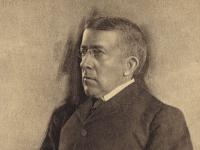Answer: The University of Pennsylvania
Charles Custis Harrison, who was born in Philadelphia in 1844, received several degrees from the University of Pennsylvania, and his connection with Penn remained steadfast and lifelong. He served as a trustee of the university for 53 years and as its provost from 1894 to 1910.
Prior to serving as provost, Harrison was a very successful sugar manufacturer in Philadelphia. So much so, that a few days after becoming provost, Harrison set up a $500,000 scholarship fund at Penn for “men of exceptional ability.” It was during his years as provost—using both his influence with Philadelphia society (Harrison was famous for his “little black notebook”) and his own money—that 63 new buildings were added to the campus, including the University Museum and the Law, Engineering, and Dental School buildings. He tripled the acreage of the West Philadelphia campus and greatly expanded the university’s financial resources. As provost Harrison was credited with having “placed Philadelphia in the forefront among centers of education.”
Harrison was a great philanthropist. He had an ability to tap friends and acquaintances, thanks to the notebook mentioned above. He raised $500,000 (half from himself) for the memorial chapel at Valley Forge, was active in the Episcopal Church, and never took a salary while employed at the university.
Some of Charles Custis Harrison's papers can be found at HSP in two collections of Harrison family papers (#2048 and #3013). Additional published resources on the Harrison family can also be found in our library.

